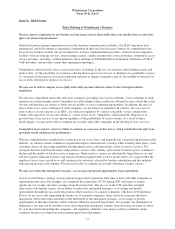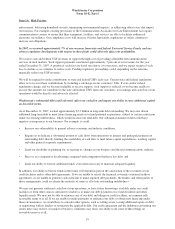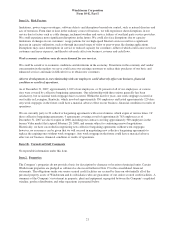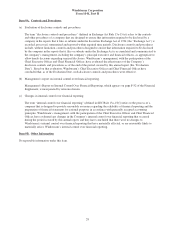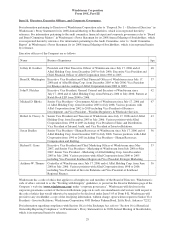Windstream 2007 Annual Report Download - page 65
Download and view the complete annual report
Please find page 65 of the 2007 Windstream annual report below. You can navigate through the pages in the report by either clicking on the pages listed below, or by using the keyword search tool below to find specific information within the annual report.
Windstream Corporation
Form 10-K, Part I
Item 1A. Risk Factors
enforcement, bolstering homeland security, minimizing environmental impacts, or addressing other issues that impact
our business. For example, existing provisions of the Communications Assistance for Law Enforcement Act require
communications carriers to ensure that their equipment, facilities, and services are able to facilitate authorized
electronic surveillance. Our compliance costs will increase if future legislation, regulations or orders continue to
increase our obligations.
In 2007, we received approximately 7% of our revenues from state and federal Universal Service Funds, and any
adverse regulatory developments with respect to these funds could adversely affect our profitability.
We receive state and federal USF revenues to support the high cost of providing affordable telecommunications
services in rural markets. Such support payments constituted approximately 7 percent of our revenues for the year
ended December 31, 2007. A portion of such fees are based on relative cost structures, and we expect receipt of such
fees to decline as we continue to reduce costs. Pending regulatory proceedings could, depending on the outcome,
materially reduce our USF revenues.
We will be required to make contributions to state and federal USFs each year. Current state and federal regulations
allow us to recover these contributions by including a surcharge on our customers’ bills. If state and/or federal
regulations change, and we become ineligible to receive support, such support is reduced, or we become unable to
recover the amounts we contribute to the state and federal USFs from our customers, our earnings and cash flows from
operations would be directly and adversely affected.
Windstream’s substantial debt could adversely affect our cash flow and impair our ability to raise additional capital
on favorable terms.
As of December 31, 2007, we had approximately $5.3 billion in long-term debt outstanding. We may also obtain
additional long-term debt to meet future financing needs or to fund potential acquisitions, subject to certain restrictions
under our existing indebtedness, which would increase our total debt. Our substantial amount of debt could have
negative consequences to our business. For example, it could:
• Increase our vulnerability to general adverse economic and industry conditions;
• Require us to dedicate a substantial portion of cash flows from operations to interest and principal payments on
outstanding debt, thereby limiting the availability of cash flow to fund future capital expenditures, working capital
and other general corporate requirements;
• Limit our flexibility in planning for, or reacting to, changes in our business and the telecommunications industry;
• Place us at a competitive disadvantage compared with competitors that have less debt; and
• Limit our ability to borrow additional funds, even when necessary to maintain adequate liquidity.
In addition, our ability to borrow funds in the future will depend in part on the satisfaction of the covenants in our
credit facilities and its other debt agreements. If we are unable to satisfy the financial covenants contained in those
agreements, or are unable to generate cash sufficient to make required debt payments, the lenders and other parties to
those arrangements could accelerate the maturity of some or all of our outstanding indebtedness.
We may not generate sufficient cash flows from operations, or have future borrowings available under our credit
facilities or from other sources sufficient to enable us to make our debt payments or to fund dividends and other
liquidity needs. We may not be able to refinance any of our debt, including our credit facilities, on commercially
reasonable terms or at all. If we are unable to make payments or refinance our debt, or obtain new financing under
these circumstances, we would have to consider other options, such as selling assets, issuing additional equity or debt,
or negotiating with its lenders to restructure the applicable debt. Our credit agreement and the indentures governing our
senior notes may restrict, or market or business conditions may limit, our ability to do some of these things on
favorable terms or at all.
19










